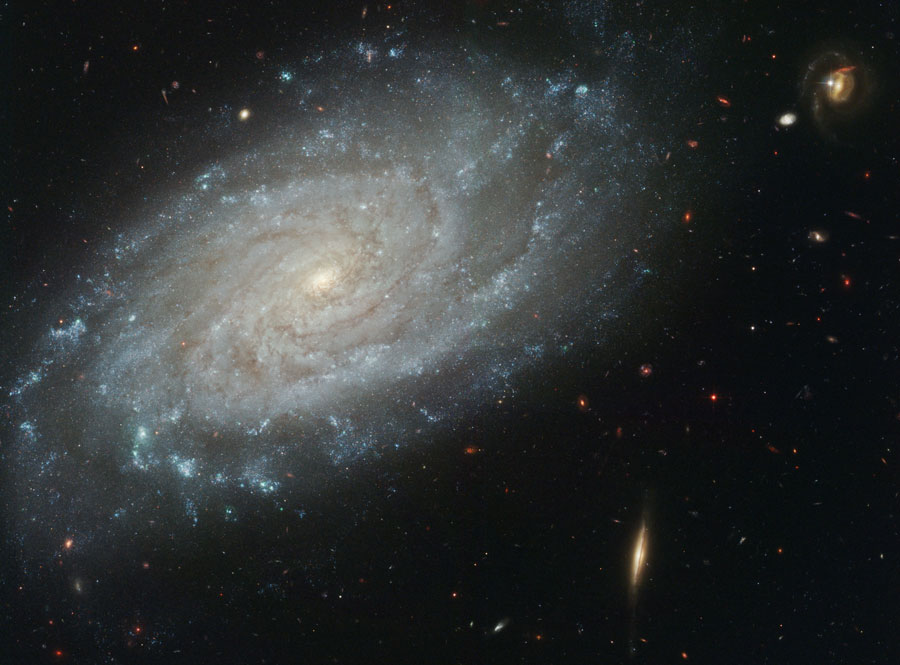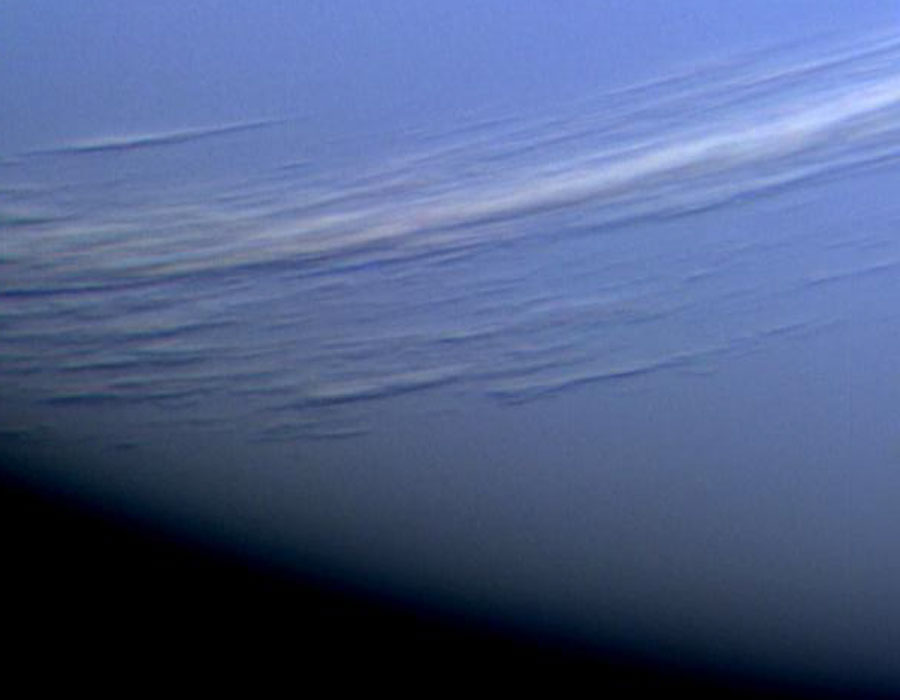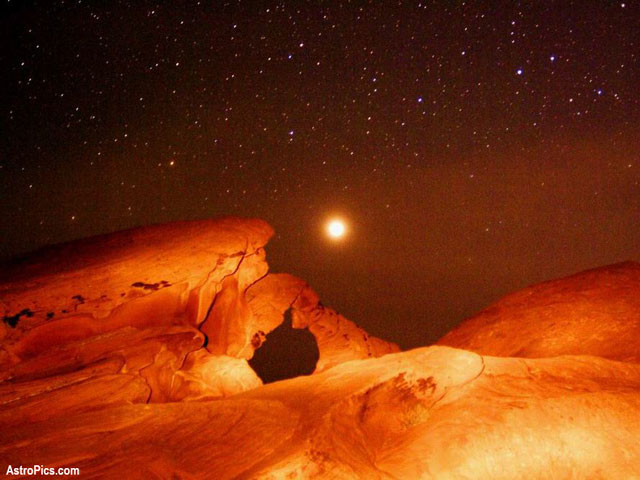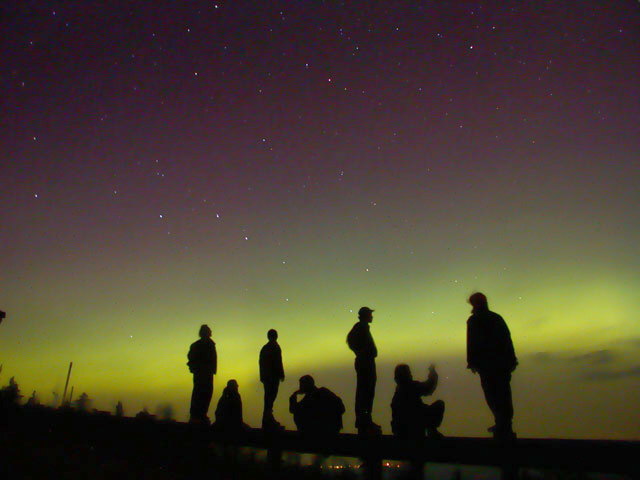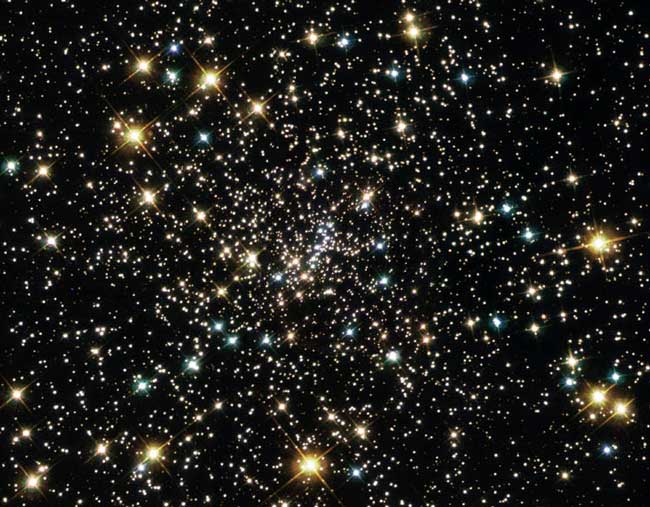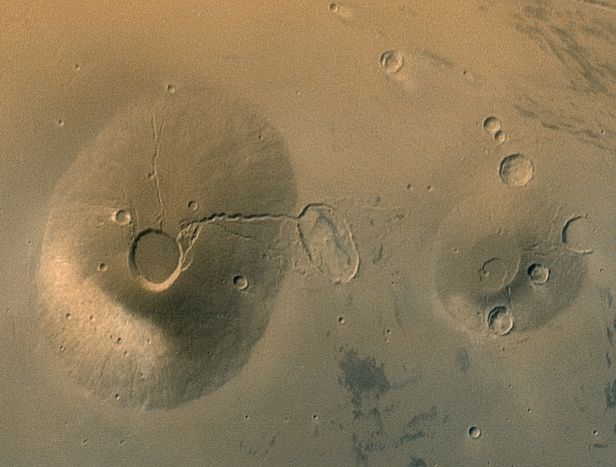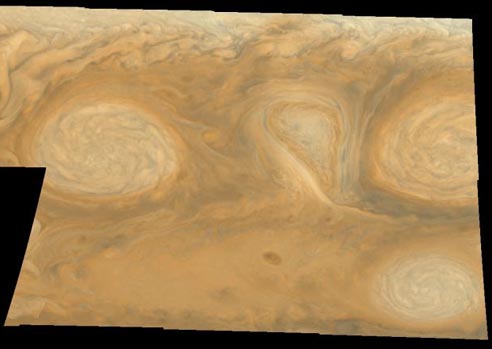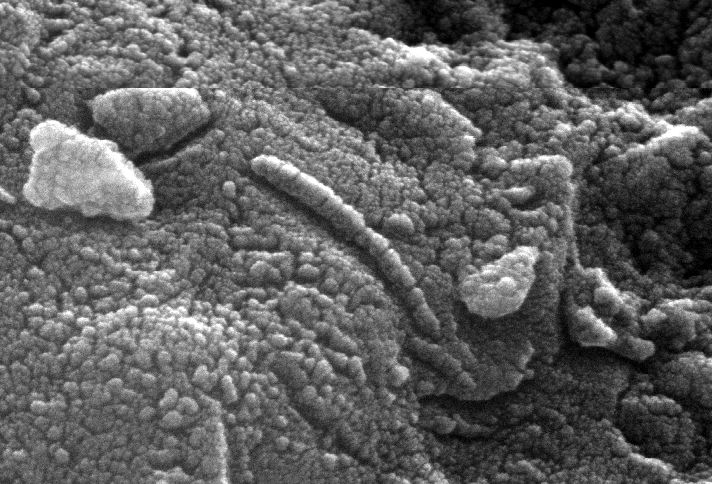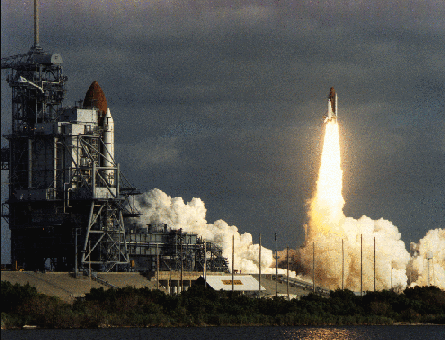| << Previous | Index | Next >> |
2015 By planet Earth's calendar, the Curiosity Mars Rover reached its 3rd anniversary on the surface of the Red Planet on August 6. To celebrate, gaze across this dramatic panoramic view of diverse terrain typical of the rover's journey to the layered slopes of Aeolis Mons, also known as Mount Sharp. Recorded with Curiosity's Mast Camera instrument, the scene looks south across gravel, sand ripples, and boulders toward rounded buttes. In the background, higher layers at left are toward the southeast, with southwest at panorama right. The individual images composing the view were taken on Curiosity's mission sols (martian days) 952 and 953 since the rover's landing on August 6, 2012.
2014 Big, beautiful spiral galaxy NGC 6744 is nearly 175,000 light-years across, larger than our own Milky Way. It lies some 30 million light-years distant in the southern constellation Pavo. We see the disk of the nearby island universe tilted towards our line of sight. Orientation and composition give a strong sense of depth to this colorful galaxy portrait that covers an area about the angular size of the full moon. This giant galaxy's yellowish core is dominated by the light from old, cool stars. Beyond the core, spiral arms filled with young blue star clusters and pinkish star forming regions sweep past a smaller satellite galaxy at the lower left, reminiscent of the Milky Way's satellite galaxy the Large Magellanic Cloud.
2013 Similar in size and grand design to our own Milky Way, spiral galaxy NGC 3370 lies about 100 million light-years away toward the constellation Leo. Recorded here in exquisite detail by the Hubble Space Telescope's Advanced Camera for Surveys, the big, beautiful face-on spiral does steal the show, but the sharp image also reveals an impressive array of background galaxies in the field, strewn across the more distant Universe. Looking within NGC 3370, the image data has proved sharp enough to study individual pulsating stars known as Cepheids that can be used to accurately determine this galaxy's distance. NGC 3370 was chosen for this study because in 1994 the spiral galaxy was also home to a well studied stellar explosion -- a type Ia supernova. Combining the known distance to this standard candle supernova, based on the Cepheid measurements, with observations of supernovae at even greater distances, can reveal the size and expansion rate of the Universe itself.
2012 Just as it captured the Phoenix lander parachuting to Mars in 2008, the HiRise camera onboard the Mars Reconnaissance Orbiter (MRO) snapped this picture of the Curiosity rover's spectacular descent toward its landing site on August 5 (PDT). The nearly 16 meter (51 foot) wide parachute and its payload are caught dropping through the thin martian atmosphere above plains just north of the sand dune field that that borders the 5 kilometer high Mt. Sharp in Gale Crater. The MRO spacecraft was about 340 kilometers away when the image was made. From MRO's perspective the parachute is flying at an angle to the surface so the landing site itself does not appear below it. Dangling from tethers and still about 3 kilometers above Mars, Curiosity and its rocket powered sky crane have not yet been deployed.
2011 What is causing these dark streaks on Mars? A leading hypothesis is flowing -- but quickly evaporating -- water. The streaks, visible in dark brown near the image center, appear in the Martian spring and summer but fade in the winter months, only to reappear again the next summer. These are not the first markings on Mars that have been interpreted as showing the effects of running water, but they are the first to add the clue of a seasonal dependence. The above picture, taken in May, digitally combines several images from the the HiRISE instrument on the Mars Reconnaissance Orbiter (MRO). The image is color-enhanced and depicts a slope inside Newton crater in a mid-southern region of Mars. The streaks bolster evidence that water exists just below the Martian surface in several locations, and therefore fuels speculation that Mars might harbor some sort of water-dependent life. Future observations with robotic spacecraft orbiting Mars, such as MRO, Mars Express, and Mars Odyssey will continue to monitor the situation and possibly confirm -- or refute -- the exciting flowing water hypothesis.
2010 Two hours before closest approach to Neptune in 1989, the Voyager 2 robot spacecraft snapped this picture. Clearly visible for the first time were long light-colored cirrus-type clouds floating high in Neptune's atmosphere. Shadows of these clouds can even be seen on lower cloud decks. Most of Neptune's atmosphere is made of hydrogen and helium, which is invisible. Neptune's blue color therefore comes from smaller amounts of atmospheric methane, which preferentially absorbs red light. Neptune has the fastest winds in the Solar System, with gusts reaching 2000 kilometers per hour. Speculation holds that diamonds may be created in the dense hot conditions that exist under the cloud tops of Uranus and Neptune.
2009 Cloudy skies over Wuhan, China hid the delicate solar corona during July's total eclipse of the Sun. Still, the Moon's silhouette was highlighted by these glistening diamonds as the total eclipse phase ended. Caused by bright sunlight streaming through dips and valleys in the irregular terrain along the Moon's edge, the effect is known as Baily's Beads, named after Francis Baily who called attention to the phenomenon in 1836. The dramatic appearance of the beads at the beginning or end of a total solar eclipse is also known as the Diamond Ring effect. In this remarkable image, a small, pinkish solar prominence can also be seen along the edge, below the diamonds.
2008 During a total solar eclipse, the Sun's extensive outer atmosphere, or corona, is an inspirational sight. The subtle shades and shimmering features of the corona that engage the eye span a brightness range of over 10,000 to 1, making them notoriously difficult to capture in a single picture. But this composite of 28 digital images ranging in exposure time from 1/1000 to 2 seconds comes close to revealing the crown of the Sun in all its glory. The telescopic views were recorded near Kochenevo, Russia during the August 1 total solar eclipse and also show solar prominences extending just beyond the edge of the eclipsed sun. Remarkably, features on the dark near side of the New Moon can also be made out, illuminated by sunlight reflected from a Full Earth.
2007 Can Mars sustain life? To help answer this question, last week NASA launched the Phoenix mission to Mars. In May 2008, Phoenix is expected to land in an unexplored north polar region of Mars that is rich in water-ice. Although Phoenix cannot move, it can deploy its cameras, robotic arm, and a small chemistry laboratory to inspect, dig, and chemically analyze its landing area. One hope is that Phoenix will be able to discern telling clues to the history of ice and water on Mars. Phoenix is also poised to explore the boundary between ice and soil in hopes of finding clues of a habitable zone there that could support microbial life. Phoenix has a planned lifetime of three months on the Martian surface.
2006 Do you see the horse's head? What you are seeing is not the famous Horsehead nebula toward Orion but rather a fainter nebula that only takes on a familiar form with deeper imaging. The main part of the above imaged molecular cloud complex is a reflection nebula cataloged as IC 4592. Reflection nebulas are actually made up of very fine dust that normally appears dark but can look quite blue when reflecting the light of energetic nearby stars. In this case, the source of much of the reflected light is a star at the eye of the horse. That star is part of Nu Scorpii, one of the brighter star systems toward the constellation of Scorpius. A second reflection nebula dubbed IC 4601 is visible surrounding two stars on the far right.
2005 Will Mars appear extremely close and bright later this month? No. Regardless of numerous urban legends circulating, Mars will appear relatively normal in August. October is the best month to see Mars this year. The red planet is now visible in the morning before sunrise. As Earth catches up to Mars in their respective orbits around the Sun, Mars will keep rising earlier in the night. On 2005 October 30, Earth will have caught up to Mars and the planets will be the nearest to each other in their orbits -- this time around. On October 30, Mars will be nearly opposite to the Sun, rise at sunset, set at sunrise, and appear highest and brightest around midnight. Also on October 30, Mars will appear brighter than it has in the past two years, although still over 10,000 times smaller and fainter than the full Moon. Earth will then pass Mars, and Mars will appear to fade. Pictured above, Mars is shown as it appeared 2003 August 27, when it appeared slightly brighter than it had in nearly 60,000 years. The foreground setting is in the Valley of Fire state park in Nevada, USA. The ellipticity of orbits primarily determines the closeness and brightness of Mars during opposition.
2004 Have you contemplated your sky recently? This week will be a good one for midnight meditators at many northerly locations as meteors from the Perseid meteor shower will frequently streak through. The Perseid meteor shower has slowly been building to a crescendo and should peak on the nights of August 11 and 12. Pictured above on 2002 August 1, a group of celestial sightseers near Quebec, Canada are treated to a dark and wondrous night sky that contained bright stars, green auroras, the band of our Milky Way galaxy, a majestic Moon rising, the International Space Station slowly gliding by, and the occasional flash of a Perseid meteor. Although no meteors were caught in this frame, the Big Dipper remained quite prominent.
2003 In our neck of the Galaxy stars are too far apart to be in danger of colliding, but in the dense cores of globular star clusters star collisions may be relatively common. In fact, researchers have evidence that the closely spaced blue stars near the center of the above image taken by the orbiting Hubble Space Telescope were formed when stars directly collided. Pictured is the central region of NGC 6397, a globular cluster about 6,000 light-years distant, whose stars all formed at about the same time. NGC 6397's massive stars have long since evolved off the main sequence, exhausting their central supplies of nuclear fuel. This should leave the cluster with only old low mass stars; faint red main sequence stars and brighter blue and red giants. However, spectroscopic data show that the indicated stars, descriptively dubbed blue stragglers, are clearly main sequence stars which are too blue and too massive to still be there. Suggestively the stragglers appear to be two and occasionally three times as massive as the lower mass cluster stars otherwise present, supporting evidence for their formation from two and even three star collisions.
2002 Findings of ancient martian microbial fossils in meteorites and liquid water related features on Mars' surface are currently controversial issues. But one thing long established by space-based observations of the Red Planet is the presence of volcanos, as Mars supports some of the largest volcanos in the solar system. This synthetic color picture recorded in March by the Mars Global Surveyor spacecraft shows two of them, Ceraunius Tholus (leftmost) and Uranius Tholus. Found north of the Tharsis region of truly large martian volcanos, these are actually two relatively small volcanos, Ceraunius Tholus being only about the size of the Big Island of Hawaii on planet Earth. Impact craters which overlay the volcanic martian terrain indicate that these volcanos are themselves ancient and inactive. North is to the right and the scene is illuminated by sunlight from the top left. A light region of dust deposited by recent global dust storms lies on the lower left flank of Ceraunius Tholus, whose summit crater is about 25 kilometers across.
2001 Explanation: Next stop: Saturn. The Cassini spacecraft, launched from Earth four years ago, has now swung past Jupiter and should arrive at Saturn in the year 2004. Pictured to the left is a parting shot from Cassini in January that would not have been possible from Earth: Jupiter showing a crescent phase. From the Earth and all points sunward of Jupiter, the gas giant will always appear more fully lit than a crescent. After arriving at Saturn, Cassini will decelerate to orbit the ringed world and send a probe to its enigmatic moon Titan.
2000 What's happened to the nucleus of Comet LINEAR? The brightest comet this year has unexpectedly broken up into many smaller pieces. The break-up occurred on or about July 25 and was noted by many astronomers around the world with particularly pioneering work by Mark Kidger (IAC). Since then astronomers had been searching in vain to find any fragments left of the nucleus, and watching to see how fast the remaining debris fades. Just three days ago the Hubble Space Telescope was maneuvered to photograph the region and recovered some of the disintegrating fragments that used to compose Comet LINEAR's nucleus. The above image covers only the very tip of an elongated diffuse train of slowly dispersing gas, dust, ice fragments, and gravel. The largest bits remaining of the badly fractured nucleus appear to be less than 30 meters across. This debris train will not collide with the Earth and so will not cause a meteor shower. Interested astronomers are now theorizing why Comet LINEAR's nucleus disintegrated into such small pieces.
1999 Comet Hale-Bopp became much brighter than any surrounding stars. It was seen even over bright city lights. Out away from city lights, however, it put on quite a spectacular show. Here Comet Hale-Bopp was photographed above Val Parola Pass in the Dolomite mountains surrounding Cortina d'Ampezzo, Italy. Comet Hale-Bopp's blue ion tail was created when fast moving particles from the solar wind struck expelled ions from the comet's nucleus. The white dust tail is composed of larger particles of dust and ice expelled by the nucleus that orbit behind the comet. Observations showed that Comet Hale-Bopp's nucleus spins about once every 12 hours.
1998 15,000 years ago a star in the constellation of Cygnus exploded -- the shockwave from this supernova explosion is still expanding into interstellar space! The collision of this fast moving wall of gas with a stationary cloud has heated it causing it to glow in visible as well as high energy radiation, producing the nebula known as the Cygnus Loop (NGC 6960/95). The nebula is located about 2500 light years away. The colors used here indicate emission from different kinds of atoms excited by the shock; oxygen-blue, sulfur-red, and hydrogen-green. This picture was taken with the Wide Field and Planetary Camera 2 on board the Hubble Space Telescope.
1997 What are those white ovals all over Jupiter? Storms! Jupiter's clouds can swirl rapidly in raised high-pressure storm systems that circle the planet. The above pictured white ovals are located near the Great Red Spot, and have persisted on Jupiter since the 1930s. The Great Red Spot has persisted for at least 300 years. Currently, no one knows why ovals last as long as they do. White ovals are confined to circular belts around Jupiter, but can interact to cause nearby chaotic cloud regions.
1996 Alien! Alien? Is this what an ancient Martian looked like? The tube-like form on the above highly magnified image is now believed by many to be a fossil of a simple Martian organism that lived over 3.6 billion years ago. If this extraordinary claim is true, this alien could hardly have been less intimidating as its fossil measures less than 1/100th the width of a human hair. A reconstruction of events indicates that the meteorite that housed this potential fossil was catapulted from Mars during a huge impact 16 million years ago and fell to Earth's Antarctica only 13,000 years ago. Evidence supporting this claim of early Martian life includes organic molecules and mineral features characteristic of biological activity found in the meteorite. NASA missions to Mars in the next few years include Mars Global Surveyor and Mars Pathfinder, which may uncover data that help confirm or refute this exciting claim.
1995 Space Shuttle Discovery launches while the Space Shuttle Columbia is readied for a future mission. Space shuttles are launched from the Kennedy Space Center in Florida. At this date there are four operating space shuttles: Atlantis, Columbia, Discovery, and Endeavour. This mission is most famous for carrying the Hubble Space Telescope into orbit. The Hubble Space Telescope is the largest public optical telescope ever to operate in orbit, and because it is above Earth's atmosphere it's photographs are more clear than any ground based telescope. Hubble continues to make fundamental discoveries about planets, stars, galaxies, comets, QSOs, and the universe we live in.
| << Previous | Index | Next >> |


